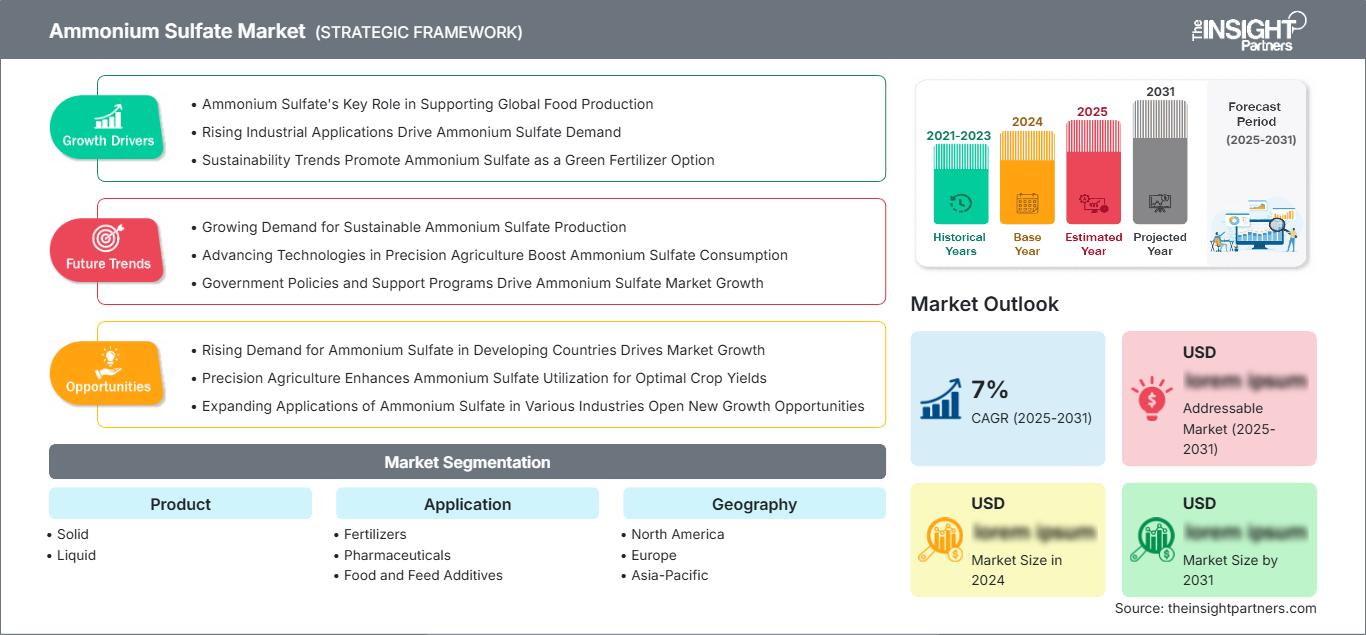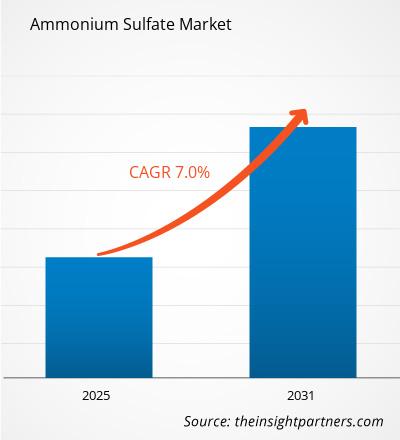Le marché du sulfate d'ammonium devrait enregistrer un TCAC de 7 % entre 2025 et 2031, avec une taille de marché passant de XX millions de dollars américains en 2024 à XX millions de dollars américains d'ici 2031.
Le rapport est segmenté par produit (solide, liquide). L'analyse mondiale est ensuite ventilée au niveau régional et par principaux pays. Le rapport présente également une analyse basée sur l'application (engrais, produits pharmaceutiques, additifs alimentaires et fourragers). L'analyse mondiale est ensuite ventilée au niveau régional et par principaux pays. La taille du marché et les prévisions aux niveaux mondial, régional et national pour tous les segments de marché clés sont couvertes dans le cadre du rapport. Le rapport indique la valeur en USD pour l'analyse et les segments ci-dessus. Français Le rapport fournit des statistiques clés sur l'état du marché des principaux acteurs du marché et offre des tendances et des opportunités de marché.
Objectif du rapport
Le rapport sur le marché du sulfate d'ammonium de The Insight Partners vise à décrire le paysage actuel et la croissance future, les principaux facteurs moteurs, les défis et les opportunités. Cela fournira des informations à diverses parties prenantes commerciales, telles que :
- Fournisseurs de technologies/Fabricants : Pour comprendre l'évolution de la dynamique du marché et connaître les opportunités de croissance potentielles, leur permettant de prendre des décisions stratégiques éclairées.
- Investisseurs : Pour réaliser une analyse complète des tendances concernant le taux de croissance du marché, les projections financières du marché et les opportunités qui existent tout au long de la chaîne de valeur.
- Organismes de réglementation : Pour réglementer les politiques et les activités de police sur le marché dans le but de minimiser les abus, de préserver la confiance des investisseurs et de maintenir l'intégrité et la stabilité du marché.
Segmentation du marché du sulfate d'ammonium Produit
- Solide
- Liquide
Application
- Engrais
- Produits pharmaceutiques
- Additifs pour l'alimentation humaine et animale
Vous bénéficierez d’une personnalisation sur n’importe quel rapport - gratuitement - y compris des parties de ce rapport, ou une analyse au niveau du pays, un pack de données Excel, ainsi que de profiter d’offres exceptionnelles et de réductions pour les start-ups et les universités
Marché du sulfate d'ammonium: Perspectives stratégiques

-
Obtenez les principales tendances clés du marché de ce rapport.Cet échantillon GRATUIT comprendra une analyse de données, allant des tendances du marché aux estimations et prévisions.
Facteurs de croissance du marché du sulfate d'ammonium
- Rôle clé du sulfate d'ammonium dans le soutien de la production alimentaire mondiale : La croissance constante de la population mondiale entraîne une demande alimentaire, qui nécessite à son tour des engrais. Le sulfate d'ammonium est un engrais azoté qui joue un rôle important dans la promotion de la production alimentaire. Son utilité dans l'apport des nutriments nécessaires est la raison pour laquelle il est couramment utilisé en agriculture, d'où une croissance constante de son utilisation.
- L'augmentation des applications industrielles stimule la demande en sulfate d'ammonium : Le sulfate d'ammonium est également utilisé dans de nombreux procédés industriels, tels que la fabrication de colorants, de médicaments et de compléments alimentaires. L'expansion de ces industries, en particulier dans les régions émergentes, augmente le besoin de sulfate d'ammonium, ce qui en fait un produit chimique bénéfique dans un large éventail d'industries.
- Les tendances en matière de durabilité favorisent le sulfate d'ammonium comme option d'engrais vert : La nécessité d'adopter des pratiques agricoles durables et l'utilisation d'engrais verts sont désormais plus pertinentes qu'auparavant. Étant donné qu'un certain pourcentage de sulfate d'ammonium est issu de processus industriels, on peut affirmer que ce produit est plus respectueux de l'environnement lorsqu'il est produit à partir de sources naturelles. Cela encouragera probablement son utilisation dans un avenir proche, car les consommateurs et les entreprises se concentrent davantage sur la durabilité dans leurs pratiques d'achat actuelles.
Tendances futures du marché du sulfate d'ammonium
- Demande croissante pour une production durable de sulfate d'ammonium : Avec une préoccupation croissante pour l'environnement, on prévoit qu'il y aura une demande pour l'utilisation d'engrais durables à l'avenir. Français Les entreprises sont tenues de rechercher de nouvelles façons de produire du sulfate d'ammonium à partir de sources durables ou à la suite d'autres processus innovants, car de telles initiatives sont en phase avec la promotion de pratiques écologiques et attireront un segment de marché conscient de l'agenda vert.
- Les technologies avancées dans l'agriculture de précision stimulent la consommation de sulfate d'ammonium : Les technologies avancées pour l'agriculture de précision, telles que les analyses de sol et les systèmes de gestion des nutriments dans un avenir proche, stimuleront également la consommation de sulfate d'ammonium. L'application de sulfate d'ammonium est courante et des applications ciblées seront adoptées comme moyen de contrôler les pertes et de maximiser la productivité, améliorant ainsi l'efficacité de l'application d'engrais, ce qui est susceptible d'entraîner une augmentation de la demande de sulfate d'ammonium.
- Les politiques gouvernementales et les programmes de soutien stimulent la croissance du marché du sulfate d'ammonium : Il est probable que les gouvernements mettront en place des politiques et des programmes de soutien visant à promouvoir l'utilisation d'engrais dans l'agriculture afin d'augmenter la fertilité des sols et la gestion des nutriments. De telles mesures pourraient encourager l'incorporation de sulfate d'ammonium dans l'une des stratégies de fertilisation équilibrée, ce qui contribuera à l'augmentation de sa valeur marchande au cours de la période de prévision.
Opportunités du marché du sulfate d'ammonium
- La demande croissante de sulfate d'ammonium dans les pays en développement stimule la croissance du marché : Il y a une révolution dans l'agriculture dans les pays en développement en raison du besoin accru de production alimentaire. Ce qui fournit un marché correspondant pour le sulfate d'ammonium car il s'agit d'un engrais azoté bon marché et efficace. De plus, les gouvernements de ces régions encouragent également l'utilisation de pratiques agricoles avancées qui, à leur tour, augmenteront encore l'utilisation du sulfate d'ammonium dans les pratiques agricoles respectueuses de l'environnement.
- L'agriculture de précision améliore l'utilisation du sulfate d'ammonium pour des rendements optimaux des cultures : L'agriculture de précision, qui est l'utilisation des données et de la technologie dans l'agriculture afin d'augmenter les rendements des cultures, est en plein essor, créant une plateforme pour le sulfate d'ammonium. Les agriculteurs recherchent une application nutritive permettant aux cultures de recevoir les nutriments dont elles ont besoin sans surplus. Le sulfate d'ammonium peut être intégré à ces systèmes, améliorant ainsi sa pénétration sur le marché grâce à une utilisation optimale et sans gaspillage.
- L'expansion des applications du sulfate d'ammonium dans divers secteurs ouvre de nouvelles perspectives de croissance : le sulfate d'ammonium peut également être utilisé dans de nombreux secteurs, tels que la purification de l'eau, l'agroalimentaire et la chimie, en plus de l'agriculture. L'expansion de ces applications offre le potentiel de développer de nouveaux marchés et de nouvelles sources d'approvisionnement, notamment dans les secteurs respectueux de l'environnement et du développement durable, ce qui représente une formidable opportunité de croissance pour les fabricants de sulfate d'ammonium.
Marché du sulfate d'ammonium
Les tendances régionales et les facteurs influençant le marché du sulfate d'ammonium tout au long de la période de prévision ont été analysés en détail par les analystes de The Insight Partners. Cette section aborde également les segments et la géographie du marché du sulfate d'ammonium en Amérique du Nord, en Europe, en Asie-Pacifique, au Moyen-Orient et en Afrique, ainsi qu'en Amérique du Sud et en Amérique centrale.
Portée du rapport sur le marché du sulfate d'ammonium| Attribut de rapport | Détails |
|---|---|
| Taille du marché en 2024 | US$ XX million |
| Taille du marché par 2031 | US$ XX Million |
| TCAC mondial (2025 - 2031) | 7% |
| Données historiques | 2021-2023 |
| Période de prévision | 2025-2031 |
| Segments couverts |
By Produit
|
| Régions et pays couverts |
Amérique du Nord
|
| Leaders du marché et profils d'entreprises clés |
|
Densité des acteurs du marché du sulfate d'ammonium : comprendre son impact sur la dynamique commerciale
Le marché du sulfate d'ammonium connaît une croissance rapide, portée par une demande croissante des utilisateurs finaux, due à des facteurs tels que l'évolution des préférences des consommateurs, les avancées technologiques et une meilleure connaissance des avantages du produit. Face à cette demande croissante, les entreprises élargissent leur offre, innovent pour répondre aux besoins des consommateurs et capitalisent sur les nouvelles tendances, ce qui alimente la croissance du marché.
- Obtenez le Marché du sulfate d'ammonium Aperçu des principaux acteurs clés
Principaux arguments de vente
- Couverture exhaustive : Le rapport couvre l’analyse exhaustive des produits, services, types et utilisateurs finaux du marché du sulfate d’ammonium, offrant un panorama global.
- Analyse d’experts : Le rapport est élaboré à partir de la connaissance approfondie d’experts et d’analystes du secteur.
- Informations actualisées : Le rapport garantit la pertinence commerciale grâce à sa couverture des informations récentes et des tendances des données.
- Options de personnalisation : Ce rapport peut être personnalisé pour répondre aux besoins spécifiques des clients et s’adapter aux stratégies commerciales.
Le rapport de recherche sur le marché du sulfate d’ammonium peut donc contribuer à la compréhension du marché et des perspectives de croissance. Malgré quelques préoccupations légitimes, les avantages globaux de ce rapport tendent à l’emporter sur les inconvénients.
- Analyse historique (2 ans), année de base, prévision (7 ans) avec TCAC
- Analyse PEST et SWOT
- Taille du marché Valeur / Volume - Mondial, Régional, Pays
- Industrie et paysage concurrentiel
- Ensemble de données Excel
Rapports récents
Témoignages
Raison d'acheter
- Prise de décision éclairée
- Compréhension de la dynamique du marché
- Analyse concurrentielle
- Connaissances clients
- Prévisions de marché
- Atténuation des risques
- Planification stratégique
- Justification des investissements
- Identification des marchés émergents
- Amélioration des stratégies marketing
- Amélioration de l'efficacité opérationnelle
- Alignement sur les tendances réglementaires






















 Obtenez un échantillon gratuit pour - Marché du sulfate d'ammonium
Obtenez un échantillon gratuit pour - Marché du sulfate d'ammonium